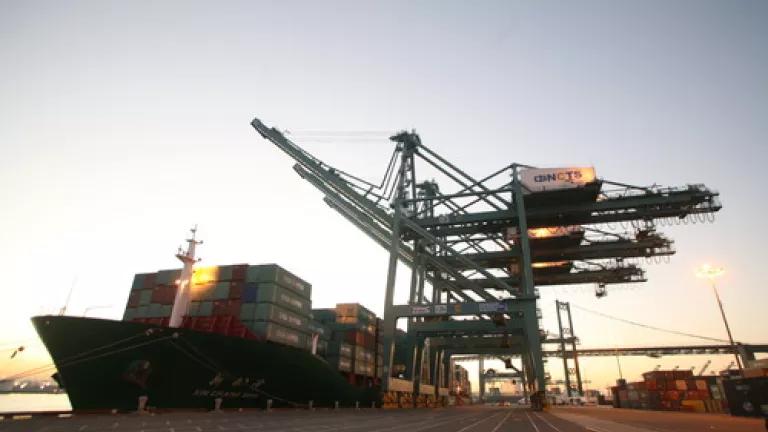
[Update: On May 21, 2012, the Port of Long Beach approved higher incentive funding amounts, consistent with our recommendation. Under the Long Beach program, ships with Tier 2 engines will get $2,500 per call (instead of $1,500), and ships with Tier 3 engines will get $6,000 per call (instead of $4,000). We applaud the port for acting so quickly in response to feedback on their program, and for their ongoing commitment to making this program a success.]
Last week the Port of Los Angeles and the neighboring Port of Long Beach each adopted programs to provide financial incentives to shipping companies to reduce their air pollution. The gargantuan cargo ships that dock at the ports emit similarly gargantuan amounts of air pollution, including diesel particulate matter and nitrogen oxides (“NOx”). The new clean ship programs are a welcome step in the right direction to clean up this mess.
Photo courtesy of Laura Kleinhenz
Both programs aim to incentivize shipping companies to buy cleaner ships and to use those cleaner ships for the calls to the Los Angeles and Long Beach ports. Under both programs, the more a ship utilizes clean technology over and above what is required by the international standards set by the International Maritime Organization, the more money the port will provide as an incentive. Both programs begin in July 2012.
Under the Port of Long Beach’s “Green Ship Award Program,” the Port of Long Beach will give a shipping company $1,500 for each call it does with a ship with a “Tier 2” engine and $4,000 for each call it does with a ship with a “Tier 3” engine. A Tier 2 engine emits less air pollution than the engines widely used today, and the Tier 3 engine is even cleaner. In 2011, only 7 of the ship calls at the Port of Long Beach were made with Tier 2 engines—that is less than 1% of all the Port’s vessel calls. By the end of the first year of the new program, the Port hopes to see 3% of its vessel calls be ships with Tier 2 engines. Tier 3 engines are not even available yet. By the year 2023, the Port hopes to have 50% of its ships be Tier 2 engines and 40% be Tier 3.
The Port of Los Angeles’ program utilizes the “Environmental Ship Index,” a relatively recently developed international clean ship indexing program that assigns ratings to ships based on how much they employ cleaner technology and cleaner fuels. The Port of LA is the first port in North America to implement the Index. A ship gets points for things like using low sulfur fuel, being able to plug into shore-side power, and using a cleaner engine. The Port of LA’s incentives will range from $250 to $3,250, depending on how many points the ship gets under the Index.
We applaud both ports for continuing to try and address ship pollution. Each Port’s program is a bit different, and both are important steps in the right direction. However, we do have a few concerns with the Ports’ approach.
First, it remains to be seen whether the incentive amounts will be enough to attract the cleanest ships to our ports. We are especially pleased that several members of the Board of Harbor Commissioners for the Port of Long Beach expressed that they would support the port paying even higher incentive amounts if needed to attract the cleaner ships. But unfortunately we do not have all the time in the world to figure out the right dollar amount that would be effective—we need reduced air pollution ASAP, to protect the health of nearby residents and to meet federal clean air standards. If the current incentive amounts do not show immediate signs of being effective, the ports need to act quickly to do what is necessary to make the program effective.
Second, the Ports have had mixed success with incentive programs like this in the past. Both Ports give financial incentives for ships that slow down to lower speeds when approaching and leaving the port, that reduces air pollution and reduces the chances of ships hitting and injuring marine mammals. The vessel speed reduction program has been successful at getting a lot of ships to slow down. But, in contrast, the Ports’ incentive program that gave incentives to shipping companies that used cleaner fuel did not have as much success. My colleagues have blogged about that program here and here.
Third, in addition to the recently adopted clean ship incentive programs, the Ports should require clean ships in its leases with marine terminal operators. The Ports own the port property, but lease it to marine terminal operators, and the ports can and do include requirements in the leases to reduce the terminal’s air pollution. As part of the 2010 Update to the Ports’ Clean Air Action Plan, the Ports committed to including cleaner ship requirements in their lease agreements starting in 2016. But the serious public health impacts from ship pollution demand that the Ports do this before 2016. In all new leases and renewed leases, the Ports must include requirements for the operators to require that over time a growing percentage of the ships calling at that terminal utilize clean technologies, such as Tier 2 and Tier 3 engines. While incentive programs can be effective, requiring cleaner ships is the only way to really guarantee clean-up.
